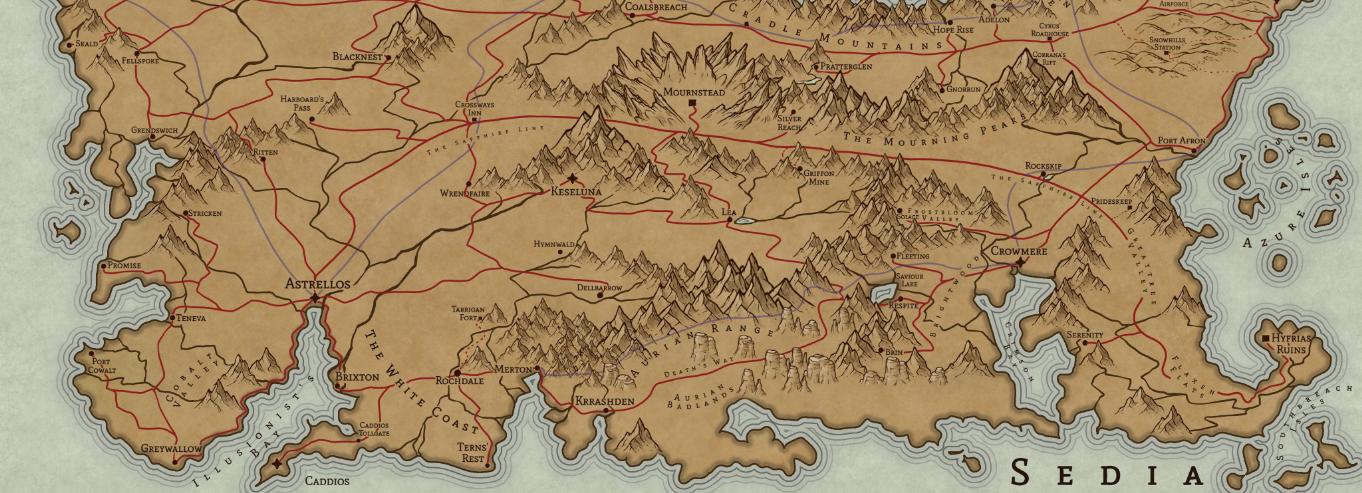A warbris is hybrid of the Kanbris Royalle (also known as the Veridian Wolfhound), and a wolf or warg. The breed specifications for Kanbris are very closely regulated, but during times of war or similar unrest, purposeful hybridisation has been recorded, though this is highly frowned upon by breeders and the Kanbris Royalle Association.
Prevalence and Controversy
While there is limited documentation of the hybridisation of Veridian Wolfhounds, the Kanbris Royalle Association (KRA) claims to reject upwards of 1,200 pups per year for "evidence of hybridisation". While it is not mandatory to have pups registered through the association, unpapered pups are practically worthless to sell, and most rejected pups are discarded. It is thought that most instances of hybridisation occur during war, when military groups needing new dogs with an extra fighting edge introduce wolf or warg blood to their dogs in an effort to make them more powerful and aggressive. The Veridian Crown and the Veridian Military have very strict laws on the use of kanbris in service due to their strong symbolic ties to Veridian royalty. Proof of this kind of hybridisation of the military's dogs would constitute dishonourable service, and the perpetrator could face prison time if charged.
As with most wolf-dog hybrids, there are farmers who claim that warbris make fantastic livestock guardian dogs, and that their additional aggressive traits and hardiness are favourable. Many farm dog mixed-breeds in Virias can be traced back to mixes of wolves, Veridian Wolfhound and other hardy breeds such as
Sedian Mountainhounds. Some sources seem to indicated that wolf-bred warbris tend to be healthier than their purebred kanbris parents, but this is fiercely argued by the KRA. Owners of wolf-bred warbris often report their dogs reaching ages upward of 17-18 years, while the usual lifespan for a kanbris is around 9-13 years on average.
Dog behaviourists, biologists and the KRA all advise strongly against breeding warbris hybrids of any kind, citing the many cons of the combinations:
- Reduction of healthy and pure wolf/warg genepools in the wild
- Degradation of the kanbris royalle breed profile
- Tendency for the resulting dogs to be hyperaggressive and not fearful of people
- Tendency for the resulting dogs to be dumped into the wild, where they become niche competition for wild wargs and wolves
- Introduction of warg-based genetic disease into dog genepools
Characteristics
The appearance of warbris, like most wolf-dog hybrids, is not very predictable. Oftentimes the resulting offspring will be larger and more muscular than both the kanbris and wolf parents, a feature that can complicate whelping and cause the death of the mother.
Traits of a warbris from a warg parent tend to be more predictable, probably because of the more distant genetic profile of the warg compared to the wolf.
Wolf-bred warbris
Much more common than warg-bred warbris, wolf hybrids are often bred by farmers or those living rurally and wanting an extra large and threatening protection dog. While it's hard to predict what a wolf warbris will look like, the resulting dogs usually inherit the longer legs from their kanbris parent, and wolf colouration tends to be dominant over that of the kanbris. Wolf-bred dogs often have issues with impacted fur and hard to manage coats. They are often large, hypermuscular and bear long canine teeth. Mentally, they are often very intelligent, bold and fearless. They are reported to have more aggression issues than their kanbris parents, and when combined with their fearless nature and a poorly prepared handler, can be incredibly dangerous.
Warg-bred warbris
While warbris of wolf heritage seem to be mostly healthy and just as fertile as their parents are, warg-bred warbris are a different story. Most warg-bred warbris are bred from a female domesticated warg and a male kanbris. The resulting pups are almost always massive, so massive that they tend to have health problems relating to their size. They have a tendency to be hard to feed and keep weight on, and burn all of their calories into forming muscle. Warg-bred warbris have a lifespan of only 8-10 years, and usually develop bone cancers, arthritis, bloat or spinal disease. They also tend to have fertility issues, the resulting animal being about 50% as fertile as its parents.




Comments